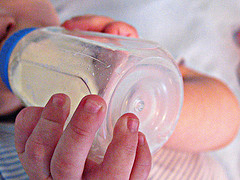
We know BPA is bad. We are comforted by plastic products now claiming to be BPA-free.
The questions remains, just what chemical replaced BPA in this BPA-free plastic? Is it really any safer?
This month’s Mother Jones reports on this study and the history of concern with plastic chemicals:
BPA exploded into the headlines in 2008, when stories about “toxic baby bottles” and “poison” packaging became ubiquitous. Good Morning America issued a “consumer alert.” The New York Times urged Congress to ban BPA in baby products. Sen. Dianne Feinstein (D-Calif.) warned in the Huffington Post that “millions of infants are exposed to dangerous chemicals hiding in plain view.” Concerned parents purged their pantries of plastic containers, and retailers such as Walmart and Babies R Us started pulling bottles and sippy cups from shelves. Bills banning BPA in infant care items began to crop up in states around the country.
Today many plastic products, from sippy cups and blenders to Tupperware containers, are marketed as BPA-free. But Bittner’s findings—some of which have been confirmed by other scientists—suggest that many of these alternatives share the qualities that make BPA so potentially harmful.
So now we have BPA-free plastics, but in some cases, the replacement chemicals are even more harmful than the BPA it is replacing. The ethics of plastic companies are also in question. Take for example Tritan:
One of the most popular BPA-free options, especially among companies catering to families and health-conscious consumers, was Tritan, a clear, sturdy, heat-resistant plastic that Eastman rolled out in 2007. (Eastman also produces the chemical that sullied the drinking water of300,000 West Virginians in January.) A company founded by alternative medicine guru Dr. Andrew Weil launched a line of Weil Baby bottles made from Tritan, which it touted as “revolutionary” and “ultra-safe” material. Thermos began churning out Tritan sippy cups, decorated with Barbie and Batman. With more and more consumers demanding BPA-free products, Nalgene, CamelBack, Evenflo, Cuisinart, Tupperware, Rubbermaid, and many other companies also worked Tritan into their production lines.
Eastman, a $7 billion company that was spun off from Eastman Kodak in the 1990s, assured its corporate customers that it had done extensive safety testing on Tritan. But its methods were questionable. According to internal Eastman documents, in 2008 Eastman signed a two-year contract with Sciences International, another product defense firm that had played a key role in the tobacco industry’s scientific misinformation campaign. On Sciences’ advice, Eastman then commissioned a study that used computer modeling to predict whether a substance contains synthetic estrogens, based on its chemical structure.
The model suggested that one of Tritan’s ingredients—triphenyl phosphate, or TPP—was more estrogenic than BPA.
Eastman, which never disclosed these findings to its customers, later commissioned another study, this one involving breast cancer cells. Again, the initial results appeared positive for estrogenic activity. In an email to colleagues, Eastman’s senior toxicologist, James Deyo, called this an “oh shit moment.”
The bottom line is there are no safe plastics, especially for the young. One of the earliest studies on plastic chemicals conducted on wildlife by zoologist Theo Colborn, Ph.D in 1987 found:
While the afflictions and species varied widely, Colborn eventually realized they had two factors in common:
The young were hardest hit, and, in one way or another, all of the animals’ symptoms were linked to the endocrine system, the network of glands that controls growth, metabolism, and brain function, with hormones as its chemical messengers.
The system also plays a key role in fetal development. Colborn suspected that synthetic hormones in pesticides, plastics, and other products acted as “hand-me-down poisons,” with parents’ exposure causing affliction in their offspring.
This study was followed up by University of Missouri’s Professor vom Saal, whom we have cited before, finding that:
Naturally occurring estrogens bind with proteins in the blood, limiting the amount that reaches estrogen receptors. But vom Saal found this wasn’t true of BPA, which bypassed the body’s natural barrier system and burrowed deep into the cells of laboratory mice.
Vom Saal suspected this would make BPA “a hell of a lot more potent” in small doses.
“A poison kills you,” says biology professor Frederick vom Saal. “A chemical like BPA reprograms your cells and ends up causing a disease in your grandchild that kills him.”
The Mother Jones article is very extensive, and I encourage you to read it. We cannot trust our government or the plastic industry to protect our families. Plastic will never be safe.
Actually, the article in Environmental Health Perspectives does conclude safe alternatives do exist for the same cost:
Results: Almost all commercially available plastic products we sampled—independent of the type of resin, product, or retail source—leached chemicals having reliably detectable EA, including those advertised as BPA free. In some cases, BPA-free products released chemicals having more EA than did BPA-containing products.
Conclusions: Many plastic products are mischaracterized as being EA free if extracted with only one solvent and not exposed to common-use stresses. However, we can identify existing compounds, or have developed, monomers, additives, or processing agents that have no detectable EA and have similar costs. Hence, our data suggest that EA-free plastic products exposed to common-use stresses and extracted by saline and ethanol solvents could be cost-effectively made on a commercial scale and thereby eliminate a potential health risk posed by most currently available plastic products that leach chemicals having EA into food products.
EA=estrogenic activity
The authors conclude:
BPA free is not EA free.
Still, I think I will avoid plastic as much as possible, which is not so easy in our culture.
Via: EcoWatch
Leave a Reply